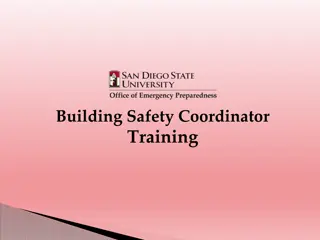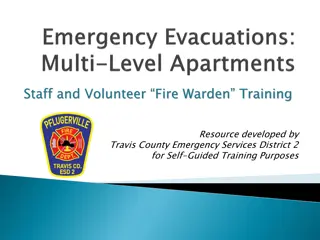Comprehensive Guide to Fire Safety Measures and Prevention Tips
This detailed guide covers essential aspects of fire safety, including theory of fire, classes of fire, prevention tips, detection and alarm systems, fire suppression methods, types of extinguishers, and more. Learn about different classes of fires, prevention measures like using designated areas for fires, understanding how to turn off utilities, and locating fire exits. Explore fire detection systems such as smoke detectors and alarms, as well as various types of fire extinguishers like dry chemical and CO2. Enhance your knowledge of fire safety to protect yourself and others in emergencies.
Download Presentation

Please find below an Image/Link to download the presentation.
The content on the website is provided AS IS for your information and personal use only. It may not be sold, licensed, or shared on other websites without obtaining consent from the author. Download presentation by click this link. If you encounter any issues during the download, it is possible that the publisher has removed the file from their server.
E N D
Presentation Transcript
Fire! Safety
Fire! Theory of Fire Fire Prevention Safety Detection and Alarm Suppression Maintenance of Fire Safety Equipment
Fire! Safety
Classes of Fire Class A Ordinary Combustibles Safety Class B Flammable Liquids
Classes of Fire Class C Electrical Equipment Safet Class D Combustible Metals
Fire Prevention Tips Only light fires in designated areas. Smoke only in designated areas. Cook only in designated areas. Do not overload electrical circuits. Do not tamper with electrical supply systems or fire safety systems. Turn off appropriate appliances at the end of the work day. Safety
Fire Prevention Tips contd Know how to turn off LPG. Know how to operate electrical breakers. Support systems with fire suppression equipment. Know where fire exits are located. Where deficiencies exist, address them. (See handout) Safety
Detection and Alarm Smoke Detector Horn & Strobe Safety Heat Sensor Bell
Pull Station esl10331 Safety
Suppression SAND Safety
Dry Chemical Extinguisher Safety
Carbon Dioxide Extinguishers CO2 extinguisher picture Safety
Other Extinguishers AFFF Aqueous-Film Forming Foam FFFP Film-Forming Fluoro Protein Halon Halon 1211 Halotron Purple K Dry Chemical Class D Dry Powder Wet Chemical Water Safety
Locating your Fire Extinguisher Extinguishers should be mounted on hangers, brackets, in cabinets, or on shelves 40 lbs. or less maximum 5ft above the floor Safety More than 40 lbs. -no more than 3 ft above the floor No obstructions In plain sight Clearly Marked
Rules For Fighting Fires 3 A s Activate the building s alarm system and notify the fire department. Safety Assist persons in immediate danger and those incapable of exiting on their own. Attempt to extinguish the fire
How to use a Fire Extinguisher P.A.S.S Pull the safety pin at the top of the fire extinguisher. Aim the nozzle towards the base of the fire. Squeeze the levers. Sweep the nozzle from side to side. Safety
How to use a Fire Extinguisher VIDEO .. Safety
Maintenance of Safety Equipment Daily Safety Weekly Monthly Yearly
Servicing Safety
Maintenance of other Fire Safety Equipment Automatic Suppression Systems Fire Alarms Fire Sprinkler Systems Fire Hoses Cabinets and Accessories Smoke Detectors/Heat Sensors Safety
Record Keeping IMPORTANT INSPECT AND MAINTAIN IN ACCORDANCE WITH THE INSTRUCTIONS ON THE EXTINGUISHER S LABEL. Safety SHOW EACH DATE OF INSPECTION AND RECHARGE BELOW DATE 02.02.2022 BY J. Brown
Fire! Emergency Management and Public Safety Administration https://www.mona.uwi.edu/public_safety/ Safety























